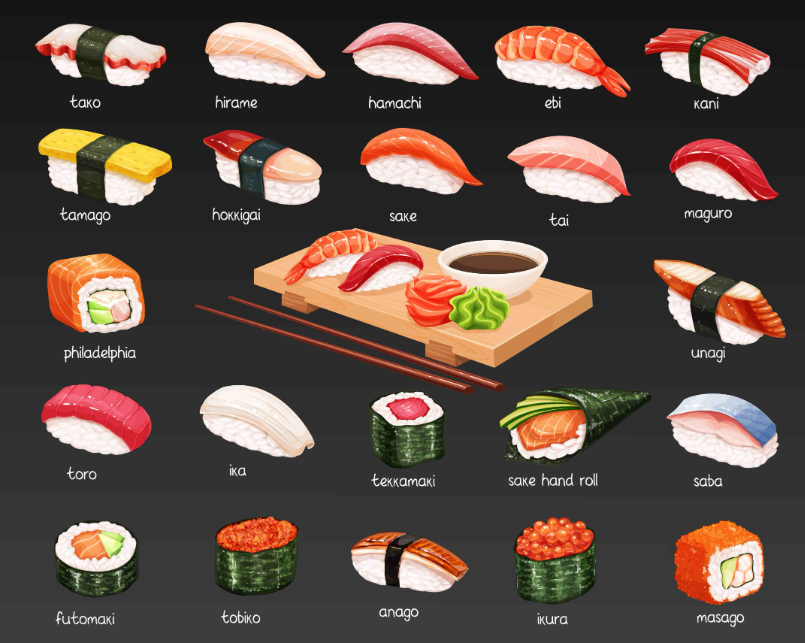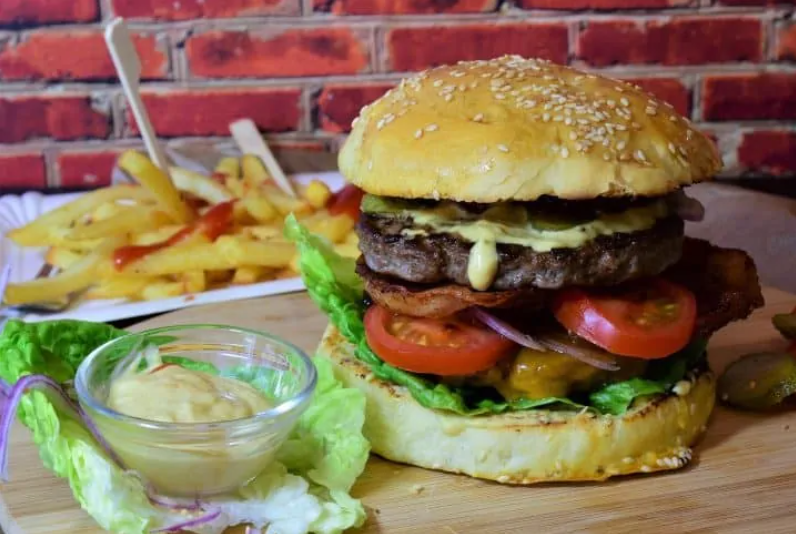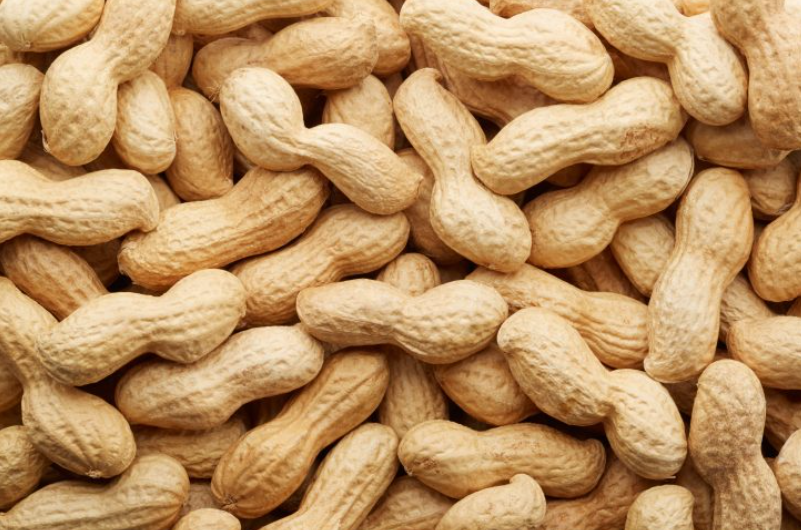People from all over the world love Japanese cuisine, but among all the amazing dishes that Japan offers, sushi might be the most popular. From food stalls to high-class Japanese restaurants, sushi is easy to find and even easier to enjoy. The best part is that there are so many types of sushi, so you can be sure to find one that suits your personal taste. Read this list of the types of sushi in order to find out more!
First, what is sushi?
Sushi, which translates to “sour,” is a traditional Japanese dish. It includes seasoned sushi rice, or “sushi-meshi,” seafood, and vegetables. Popular choices for seafood in sushi are salmon (which is “sake” in Japanese, hence the name, sake sushi), tuna, squid, and eel.
If you’ve ever ordered a sushi platter from a sushi bar before, then you’ll notice that restaurants often serve them with wasabi, soy sauce, and pickled ginger. Wasabi, or Japanese horseradish, is a spicy green paste while soy sauce adds a salty flavor to the sushi. When eating sushi, you’ll want to season or dip your sushi with these two, but it’s up to you how much you want to add. In fact, some types of sushi already pack enough flavor on their own!
On the other hand, pickled ginger serves as a side that you eat in between eating different types of sushi. The pickled ginger cleanses your palate and allows you to taste each type of sushi well.
Because of its ingredients, most sushi is high in protein and low in fat. It also contains omega-3 fatty acids which help reduce your body’s cholesterol levels. This makes sushi a popular choice even among those who are trying to live a healthier lifestyle.
Second, what isn’t sushi?
Many people mistake sushi and sashimi for one another. This is understandable as sushi and sashimi both typically use seafood. However, they aren’t the same, and knowing the difference will save you a lot of time (and embarrassment) when ordering in Japanese restaurants. So, sushi vs. sashimi: what exactly is the difference?
Well, the fundamental difference is that sashimi isn’t served with rice like sushi is. Sashimi, where “sashi” means “pierced” and “mi” means “body,” refers to a piece of meat that is usually, but not necessarily, raw seafood. Salmon, squid, shrimp, tuna, and octopus are usually used for sashimi and served with soy sauce and wasabi paste.
If it’s still a bit difficult to understand what sashimi is, think of sashimi as the raw seafood toppings in most sushi types.
Now, with the basics down, it’s time to list down the different types of sushi, starting off with those popular in Japan and ending with those favored in the United States.
Nigirizushi
When you think of sushi, you’re probably imagining a small oblong of sushi rice topped with a cut of raw fish. This type of sushi is called nigirizushi or “hand-pressed sushi.” Nigiri is the most traditional form of sushi, and chefs prepare this by pressing the rice into bite-sized oblong with their hands and topping it with either a thin or thick slice of sashimi.
A popular type of nigiri is temari sushi, which is round instead of oblong. Temari sushi is usually colorful and pleasing to look at because of the bright colors of the fresh fish and vegetables topping the seasoned rice. This type of nigiri sushi is named after the Japanese folk art, temari, which are colorful balls made from fabric and used in handball games.
Makizushi
Some call this type of sushi “maki roll,” but simply maki, which already translates to “roll,” will suffice. Makizushi is a type of sushi where the ingredients are wrapped in sushi rice and rolled in nori or dried seaweed using a bamboo mat. Once they’ve secured the sushi roll, chefs then cut the roll into smaller pieces.
This rolled sushi has its own different types: hosomaki, chumaki, futomaki, uramaki, and temaki. The first three types are similar, varying only in their thickness. The hosomaki is a thin roll. The chumaki is a medium roll. Finally, the futomaki is a thick roll. The uramaki and the temaki differ from the other three. Uramaki, or the “inside-out roll,” has rice as its outer layer while nori is on the inside. On the other hand, the temaki, “or hand roll,” is cone-shaped and is relatively easier to make than other kinds of makizushi.
Gunkan sushi
Gunkan sushi is much like the maki sushi, except it is rolled like a ship, which “Gunkan” translates to. To prepare this, chefs roll nori around sushi rice and place the ingredients on top of the rice instead of inside. This gives the illusion of a ship instead of the traditional makizushi or sushi roll.
Chirashizushi
The chirashizushi or “scattered sushi” differs from the other types of sushi based on its preparation and presentation. As the name suggests, chirashizushi is actually a bowl of sushi rice with toppings scattered on top. In Japan, most chefs top their chirashizushi with salted fish and pickled vegetables. In the US, most chefs will use raw tuna, raw salmon, and sweet eggs.
Some examples of chirashizushi are bu-en sushi, tekone sushi, and barazushi.
Narezushi
The narezushi, or “salted fish” or “matured sushi,” is a traditional type of sushi. To make this, chefs preserve fish in salt and rice, allowing it to ferment for months long. Historians believe the narezushi to be the oldest type of sushi, which can be traced back to other countries in Southeast Asia, such as Korea and China.
Today, the most popular kind of narezushi is the funazushi, which chefs ferment between six months to five years. Buying yourself a funazushi might burn a hole in your pocket because of how expensive it is, but at least your food won’t be expiring soon. The shelf life of funazushi can sometimes last for up to six months or more.
The funazushi is popular for its powerful smell and extremely sour flavor, so it might be better for you to eat this in small bites. Some recommend eating this unique dish with alcohol, too.
Oshizushi
Oshizushi is like nigirizushi. To make it, chefs also press the rice. The difference is that while nigirizushi is typically oblong-shaped, the oshizushi is rectangular. Some also call the oshizushi “hako-sushi” or “box sushi.”
To make oshizushi, chefs use oshibako, which is a wooden mold. First, chefs fill the bottom of the oshibako with seasoned sushi rice, followed by a layer of toppings. Then, they use the oshibako’s lid to press down on the ingredients to ensure that they hold their shape. Last, they cut the molded sushi into smaller, bite-sized squares.
Sasazushi
The sasazushi is one of the types of sushi that doesn’t use nori. Instead of dried seaweed, the sasazushi uses bamboo leaves. Chefs place the pressed sushi rice on top of a bamboo leaf and top it off with salmon or some other fish, vegetables, and sometimes eggs, before wrapping it in the bamboo leaf.
Kakinohazushi
Similar to the sasazushi, the kakinohazushi forgoes seaweed in its ingredients list. The chef presses the sushi rice into the desired shape, tops it with a piece of fish, such as mackerel, salmon, or prawn, and then wraps it into a package using a persimmon leaf. While this is not as common in Western sushi restaurants, this type of sushi is quite popular in Nara, Japan.
Inarizushi
The types of sushi that are popular in Japan differ sometimes from the types of sushi that are popular in the US. The inarizushi or “tofu pouch” belongs in the latter category. If you find yourself in a sushi restaurant in the US, then you’re likely to see inarizushi on the menu.
Inarizushi is a type of stuffed sushi, where the sushi rice and fillings are stuffed in deep-fried tofu pouches. Chefs typically use thinly sliced tofu, sweetened in soy sauce. Because of this, some also call the inarizushi “brown bag sushi.”
Chakinzushi
Chakinzushi is another type of stuffed sushi. However, instead of a tofu pouch, chefs use a paper-thin egg wrap instead. They place the sushi rice and other fillings in the middle of the egg wrap and seal it closed with a string of scallion. The chakinzushi looks like a pouch, and it represents good fortune, which is why it is a popular dish for celebrations and gatherings.
Sugatazushi
The sugatazushi, or “fish-stuffed sushi,” is similar to the inazi and chakin sushi except the sugatazushi uses a whole fish instead of a tofu or egg pouch. Chefs use a cured whole fish, typically mackerel, salmon, or trout, so that it is still edible.
California Roll
Out of the different types of sushi rolls, the California roll might be the most popular in the United States. Based on the traditional maki sushi of Japan, the California roll is an inside-out sushi roll. Chefs typically use imitation crab, avocado, cucumber, and sometimes tobiko, or “flying fish roe,” for the filling. They wrap these in seaweed before finally rolling them in pressed sushi rice.
Tempura Roll
The tempura roll is a type of sushi that also has rice on the outside. Chefs first prepare shrimp tempura. Then, they press rice onto a nori sheet and roll the nori around the tempura, along with strips of vegetables such as cucumber and avocado. Of course, chefs ensure that the side of the nori with pressed rice is on the outside in classic inside-out fashion.
Spicy Tuna Roll
Another popular type of sushi in the United States is the spicy tuna roll. Chefs prepare clean cuts of raw tuna, usually mixed with spicy mayonnaise, before wrapping it with rice and nori. In Japan, sushi isn’t usually spicy unless you add wasabi as a condiment. The spicy tuna roll, on the other hand, is spicy enough on its own.
Dragon Roll
If you have a surplus of ingredients after you’ve prepared tempura rolls, then why not make dragon rolls while you’re at it? They have the same ingredients and call for the same technique as they are both inside-out sushi rolls. The difference is that thinly sliced avocado and tobiko top the dragon roll with a drizzle of spicy unagi sauce and mayonnaise to finish it off.
Spider Roll
The spider roll is a type of sushi that uses deep-fried soft-shell crab as its key ingredient. To add to the flavor, chefs also include cucumber, lettuce or daikon sprouts, avocado, spicy mayonnaise, or tobiko in the filling.
Rainbow Roll
An Instagram favorite is the rainbow roll. Just as its name suggests, this type of sushi is distinctly colorful. Different types of sashimi give this sushi roll its appealing appearance. Of course, it isn’t only eye-catching but also delicious.
You might notice that a rainbow roll tastes similar to a California roll, and that’s because they are essentially the same. Typically, a chef will first make a California roll and then simply add the sashimi on top in order to complete the rainbow roll.
Philly Roll
The Philly roll is another type of sushi that you’ll likely find in American sushi restaurants. While the name suggests it is from Philadelphia, this is actually not the case. This type of sushi’s name comes from one of the key ingredients chefs used to make the sushi roll: the Philadelphia cream cheese. Similar to the California roll, the Philly roll is an inside-out sushi roll, but the outermost layer is sashimi.
Vegetarian Roll
If you don’t eat seafood or meat, then don’t worry. There’s a type of sushi for you too! The vegetarian sushi roll is yet another popular menu item in most Western sushi bars. This inside-out sushi roll is stuffed with different kinds of vegetables, such as cucumber and avocado. It doesn’t have any kind of seafood or meat, so you won’t have to worry. Just dig in!
Volcano Roll
The volcano roll is a Western take on the Gunkan sushi. Chefs serve this roll flat on the plate, with the toppings piled on top to give the illusion of a volcano exploding. This type of sushi’s outer layer is the nori, with the rice inside.
Tiger Roll
If you aren’t a big fan of raw meat but still want to try sushi, then why not try the tiger roll? Popular in North America, the tiger roll is one of the rare types of sushi that doesn’t contain raw seafood. Instead, this sushi roll features fried shrimp tempura, imitation crab, cucumber, avocado, and tobiko rolled inside a layer of sushi rice and nori seaweed.


